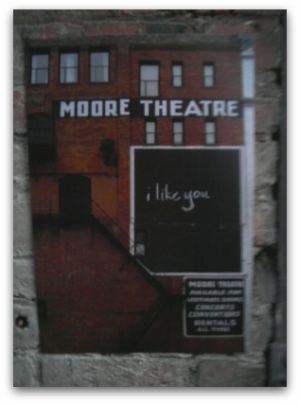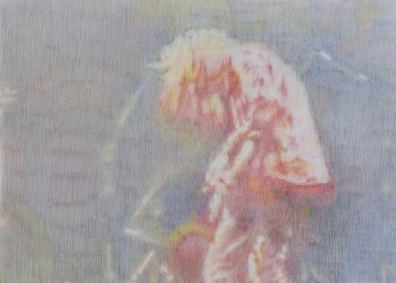Enjoying a conversation with a hospital security guard who once slammed a man face first into a glass wall for spitting on her, I missed the fact that I’d followed the line out onto Lead Pencil‘s ramp rising on a steep diagonal at Seattle’s Moore Theatre.
I’m afraid of heights. Titled Exit Ramp, the piece cut the theater in half and gave those traveling on it a new view of the space below. What that new view was I can’t say. As my knees locked, I focused on a woman in a wedding dress with gray ashes on her white-washed face who was leaning out from the balcony above and singing Mozart.
The song and the sight of her (old-worldly with a hung-in-the-closet, suppressed glamour), distracted me from an interview that came to mind at this most inopportune moment. In it, Brendan Kiley asked Lead Pencil’s Annie Han about her fears for Exit Ramp.
.
The eternal fear of structural collapse and bodily injury on any
project bigger than a man is tall.
Exit Ramp is part the Free Sheep Foundation‘s Moore Inside Out, a Saturday-night only project with 50 Seattle artists and performers that treated the whole theater as a gallery, including stairs and corridors, basement and backstage.
Thousands showed up. As Kiley wrote in his preview,
Free Sheep roots out forgotten places, their histories and memories,
and distills them into potent, one-shot events that leave indelible
burns on the city’s collective memory. Free Sheep happenings are
mayflies on fire.
Lines curved around the block to get in. Once inside, there was more waiting. Few appeared to have any idea of what they were waiting for. People joined a line and shuffled along in a collective mood of happy-to-be-surprised.
Not everybody, of course. I ran into an art historian who said, “Typical Seattle mediocrities.” She was waiting for her yoga teacher to perform and looked as if she were holding her breath.
The crowd was the thing. Seattle is frequently a place where an audience is hard to come by, which means this audience – everybody there for performance art – was heartening to itself.
Something important got lost in the self-congratulations, however.
Bryon Au Yong’s Piano Roll. Brilliant. But if ever an
artist needed a silent place, it’s Yong. Who realized that this man winding rolls of white paper was making music, and that the paper is his version of a piano? Nobody I saw. He could
have been part of a stage crew, late to tidy props. Even if a few knew who he was and what he was doing, they could barely hear him the din.
When he performs again but on a stage, I hope to be in a seat.
Susan Robb stood out.  In
In
the alley entrance to the theater
(echoing the theater’s policy of making non-whites enter in the rear
till after World War II ended), she passed out printed stacks of posters featuring a blank, black square on the alley’s wall.
People wrote on the image with chalk. (If I could do it over, I’d write, Fear of Heights.)
We
wrote on an image of a wall and posted the results on the wall,
covering its brick expanse with a corner of itself, turning a
fragment into a whole and referring (black blank space) to the
theater’s largely forgotten racist history.
I loved Gretchen Bennett‘s Dive: Pastel drawings of Kurt Cobain based on online imagery were restored to an image stream projected in two alcoves.
 Wandering through the crowds was Orange Man (Ben Beres). He looked as if he’d dyed himself that shade, part fake tan and part fatal hepatitis. Fun times. Ezra Dickinson took a three-hour walk down a hallway, met his video-projection and stopped. His intensity imposed a pocket of respectful silence around him.
Wandering through the crowds was Orange Man (Ben Beres). He looked as if he’d dyed himself that shade, part fake tan and part fatal hepatitis. Fun times. Ezra Dickinson took a three-hour walk down a hallway, met his video-projection and stopped. His intensity imposed a pocket of respectful silence around him.
Iole Alessandrini‘s landscape of CD covers was nice (Solidarity and Resiliance). Beliz Brother‘s tower from old horsehair and plaster Moore box ornaments in the lobby was just dumb. Why clean them up and make a tower? They would have been fine as rubble on the floor, maybe with a couple of Brother’s blue lights underneath.
The murals and names in street calligraphy of performers from the Moore’s history lit dark landings and trailed down staircases.
Megan Mertaugh‘s pile of watermelons stacked in an old bathroom became signatures of the evening when she passed them out. Some people rolled them in hallways. Others carried them like children in arms. Men wore them under their shirts, like a pregnancy.
A small dump of a room off a rickety corridor, long closed, had a sign relit for the occasion: Coffee Shoppe, but left on the floor. This is where blacks, Asians, poor whites and Jews were consigned for refreshments. It’s a bat cave of American cultural history, formidable in its layers of grime and dust. Free Sheep founders D.K. Pan and NKO wisely decided to leave it as it is, because it’s perfect.
Back in the theater, a crowd cheered those climbing Lead Penci’s Exit Ramp. Some people scurried along, but other paused to bask in the applause and even dance: the audience as performers entertaining the audience as spectators.
(flickr photos here.)
Previous from Free Sheep: the Bridge Motel. Two years ago, Free Sheep and Seattle School invited a small army of artists to take over a low-rent motel slated for the wrecking ball. Again, thousands showed up, reminding the Seattle art community that it exists. (Preview here, review here.)



Leave a Reply